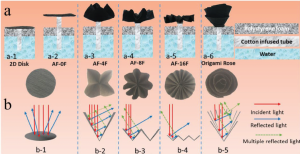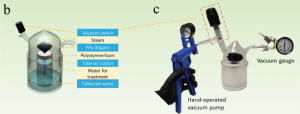The Black Tulip is a classic 19th century novel by Alexander Dumas. It offers exactly what one might expect from the author of The Three Musketeers and The Count of Monte Cristo; a swashbuckling story about revenge, justice, and love in Holland’s halls of power.
In a surprise narrative twist worthy of the man himself, it now serves as the inspiration behind a recently published water purification technique.
One common class of water purification devices consists of three main elements: a reservoir for dirty water, a heating element, and an apparatus for collecting condensed steam. The American team in question focused on improvements to the heating element and the collection apparatus.

The six filtration paper designs.
Dumas’ influence is seen in the design of the heating element. Using specially coated black origami paper, the team fashioned five different designs, which were then exposed to sunlight in the presence of dirty water to establish which shape would most effectively heat up and evaporate water. The optimized black flower enabled efficient conversion of solar energy to evaporation (see above).
Previous devices have often encountered problems with the collection step of the purification. The water sometimes gets stuck on the heating element or is lost completely from the collection device. The team sought to address these problems by enclosing their black flower in a portable low pressure compartment (see below).

The complete purification device.
With an optimized device in hand, the team tested it against water collected from the Colorado River and the Gulf of Mexico. The device removed bacteria and lowered the levels of alkalinity and hardness to well below the WHO recommended limit for drinkable water.
The results of this study are certainly promising, and with luck, perhaps a new trend in material science might be born. The Dickensian perovskite solar cell or perhaps the Tolstoy’s triboelectric nanogenerator would both be welcome additions to the field.

















